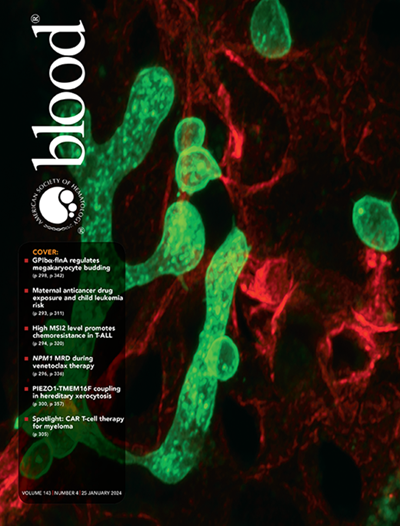IF 23.1
1区 医学
Q1 HEMATOLOGY
引用次数: 0
摘要
多次复发毛细胞白血病和变型(HCL/HCLv)的主要目的是确定戊他汀-利妥昔单抗(DCFR)和苯达莫司汀-利妥昔单抗(BR)的总缓解率(ORR)是否分别超过利妥昔单抗的历史水平(~40%),而不是65%。两种方案的前瞻性数据均未报道。56例患者接受6个28天周期的利妥昔单抗(375 mg/m²,第1、15天)和苯达莫司汀(90 mg/m²,第1、2天)或戊他汀(4 mg/m²,第1、15天)。资格要求≥2种嘌呤类似物,或初始反应<1年的一种加利妥昔单抗。研究了完全缓解(CR)和最小残留疾病(MRD),并确定了无进展生存(PFS)和风险比(HR)。虽然患者通过随机分配来增加两个治疗组的同质性,但DCFR组先前的嘌呤类似物较少(p=0.021),基线骨髓HCL/HCLv浸润较低(p=0.013)。DCFR和BR的orr分别为93%和86%,95%可信区间(95% ci)分别为83-102%和73-99%,均超过了主要目标(40%支持65%,p均<0.0001)。CR和无mrd CR和中位PFS的比率(141个月vs 50个月,HR 0.63, 95%CI 0.32-1.25)在数值上倾向于DCFR,但该组显著富集了较低的先前嘌呤类似物和骨髓浸润,每一个都与事后更好的反应相关。特别是对41例经典HCL患者的事后亚组分析表明,DCFR与BR的任何优势都可能适用于更有利的患者。DCFR和BR对多次复发的HCL/HCLv均有较好的疗效。考虑到不均匀的基线风险和试验设计,可能的DCFR优势是假设产生的。NCT01059786。本文章由计算机程序翻译,如有差异,请以英文原文为准。
Phase 2 trial of rituximab with either pentostatin or bendamustine for multiply relapsed or refractory hairy cell leukemia.
The primary objective in multiply-relapsed hairy cell leukemia and variant (HCL/HCLv) was to determine if pentostatin-rituximab (DCFR) and bendamustine-rituximab (BR) each have overall response rate (ORR) exceeding that historically achieved by rituximab alone (~40%) in favor of 65%. Prospective data was unreported for either regimen. Fifty-six patients received six 28-day cycles of rituximab (375 mg/m² days 1, 15) with either bendamustine (90 mg/m² days 1, 2) or pentostatin (4 mg/m² days 1, 15). Eligibility required ≥2 purine analogs, or one plus rituximab for initial response <1 year. Complete remission (CR) and minimal residual disease (MRD) were studied, and progression-free survival (PFS) with hazard ratios (HR) determined. Although patients were assigned to either regimen through randomization for increasing homogeneity of the two treatment groups, the DCFR arm had fewer prior purine analogs (p=0.021) and lower baseline marrow HCL/HCLv infiltration (p=0.013). ORRs for DCFR and BR were 93% and 86%, 95% confidence intervals (95%CI) 83-102% and 73-99%, each exceeding the primary objective (40% in favor of 65%, p<0.0001 for each). Rates for CR and MRD-free CR and median PFS (141 vs 50 months, HR 0.63, 95%CI 0.32-1.25) numerically favored DCFR but that arm was significantly enriched with lower prior purine analogs and marrow infiltration each of which was associated post hoc with better response. Post hoc subgroup analysis particularly for the 41 patients with classic HCL suggested any superiority of DCFR vs BR might apply to the more favorable patients. DCFR and BR were highly effective in multiply relapsed HCL/HCLv. Possible DCFR superiority was hypothesis-generating, given uneven baseline risks and trial design. NCT01059786.
求助全文
通过发布文献求助,成功后即可免费获取论文全文。
去求助
来源期刊

Blood
医学-血液学
CiteScore
23.60
自引率
3.90%
发文量
955
审稿时长
1 months
期刊介绍:
Blood, the official journal of the American Society of Hematology, published online and in print, provides an international forum for the publication of original articles describing basic laboratory, translational, and clinical investigations in hematology. Primary research articles will be published under the following scientific categories: Clinical Trials and Observations; Gene Therapy; Hematopoiesis and Stem Cells; Immunobiology and Immunotherapy scope; Myeloid Neoplasia; Lymphoid Neoplasia; Phagocytes, Granulocytes and Myelopoiesis; Platelets and Thrombopoiesis; Red Cells, Iron and Erythropoiesis; Thrombosis and Hemostasis; Transfusion Medicine; Transplantation; and Vascular Biology. Papers can be listed under more than one category as appropriate.
 求助内容:
求助内容: 应助结果提醒方式:
应助结果提醒方式:


